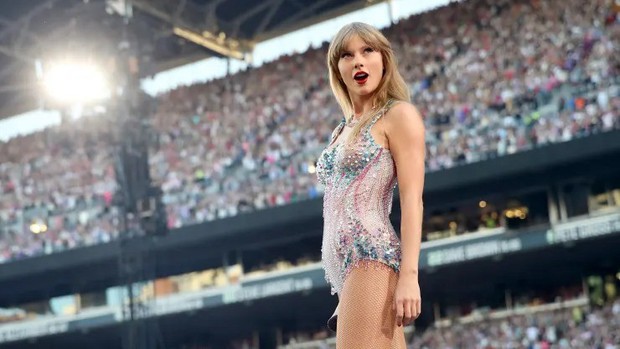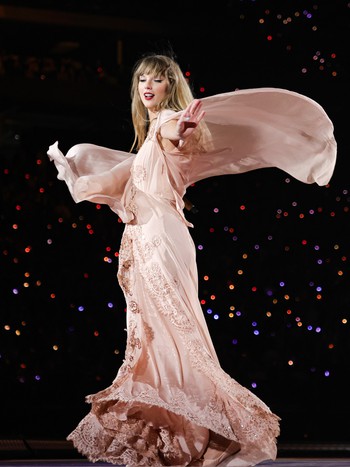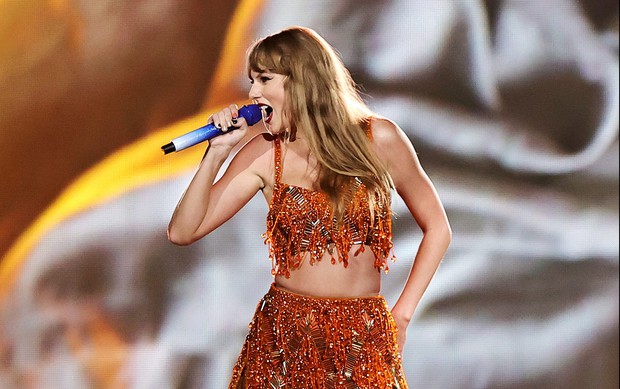The economic boost from Taylor Swift has caused many experts to analyze. Some say the economic growth from Taylor Swift’s concerts has been overblown.
Brendan Rynne, an economist at KPMG – one of the world’s largest auditing firms – said that despite the media hype around the so-called “Swiftonomics” (Taylor Swift economy – PV) and “Swiftflation” (referring to the inflationary impact of the Taylor Swift show), the net increase to GDP from the American singer’s Australian tour is still much lower than most previously predicted.
“There are many estimates that The Eras Tour will bring an additional 140 million USD to the economy, while the concerts reach up to 500 million USD and even more than a billion USD. However, the reality is that the net economic impact is likely to be much less,” Dr. Rynne said in the newly published analysis.

The Eras Tour by Taylor Swift. Photo: Getty.
Increase spending
Swifties (Taylor Swift’s fans – PV) are expected to spend about 140 million USD to buy tickets to see the female singer. About 98% of tickets purchased were purchased by locals, which will have no net economic impact on the March quarter gross domestic product (GDP) report.
The real economic recovery has come from international tourists flying to Australia to see pop superstars perform in the country’s two biggest cities. Their spending will be counted as local exports through tourism.
Dr Rynne said pre-COVID-19 data showed the average international visitor to Australia stayed 11 days and spent around $6000.
“Based on the assumption that the average international fan has a similar spending level, in addition to spending $500 on a concert, they can spend an additional $5,500,” he said.
About 25% of Taylor Swift’s total revenue will likely be paid for stage set-up and dismantling costs, injecting further activity into the economy. According to Dr. Rynne, the main cost paid is labor.
“Economic impact is overstated”
Dr. Rynne assessed that Taylor Swift was on track to earn $110 million in pre-tax profits from the tour in Australia.
A portion of these profits may be transferred to the singer personally in the form of fees, and she will be taxed at her marginal tax rate (the percentage calculated on the next dollar of taxable income payable – PV) of this country.

Experts say that Taylor Swift’s concerts in Sydney and Melbourne will only contribute an additional $10 million to the Australian economy, while the singer could earn more than $100 million in profits from her tour in Australia. Australia is part of The Eras Tour. Photo: Getty.
The remainder will be transferred to the singer’s overseas company, which can benefit from a 5% withholding tax rate under the US-Australia tax treaty. Taylor had an after-tax profit of $101.7 million, which subtracts the activity in the national accounts because it is considered an import of services.
Dr. Rynne estimates the net economic effect of The Eras Tour at $10 million, or 0.002% of GDP.
Event Pty Ltd director Simon Thewlis agrees estimates of economic growth from Taylor Swift’s concerts are overblown.
According to a new report from Japanese investment bank Nomura, Taylor’s global tour has certainly helped the local economy. But the bank questions the extent of the tour’s impact on national data.
Nomura’s global economist Si Ying Toh believes that Taylor Swift’s consumer push is certainly appealing to economic analysts, but the total macroeconomic impact may have been overblown.
According to Nomura’s estimates, from the first quarter to the third quarter of 2023, Taylor Swift’s tour increased nominal US retail sales by 0.03% and real gross domestic product by 0.02%.
According to the business’s calculations, for the whole of 2023, the female singer’s tour accounts for 0.5% of nominal consumption growth.
According to STR data cited by Toh, stops on The Eras Tour saw a 3.1 percentage point increase due to inflation during the month Taylor Swift visited. Data from hotel booking platform Trivago shows similar increases.
Looking specifically at Chicago, Toh estimates hotel prices have increased 3.1 percentage points thanks to the singer’s three performances there. The third most populous city in the US saw occupancy rates increase 8.1 percentage points and hotel revenue per room increase 59% during Taylor Swift’s tour.

Since then, the Illinois consumer price index (CPI) has increased by 0.5 percentage points based on the female singer’s tour alone. CPI is the consumer price index, a percentage index to reflect the relative change in consumer prices over time.
Toh points out these improvements are less likely to materialize in national-level statistics from larger economies such as the US, UK or Japan. However, she believes that this major tour is still worth considering as a potential economic catalyst in many countries around the globe.
Internationally, small economies like Singapore and Sweden could receive the biggest macro boost from Taylor Swift’s tour.
“Externalities play an important role in economic modeling, whether in the form of extreme weather events, pandemics or pop concerts. In recent years, tours have developed not only into a social phenomenon but also have the potential to become an important driver of economic activity” – analyzed Si Ying Toh.
Relative Articles
None found





